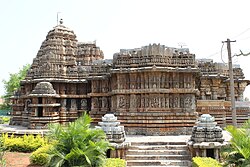Haranhalli
| Haranhalli | ||
|---|---|---|
|
|
||
| State : |
|
|
| State : | Karnataka | |
| District : | Hassan | |
| Location : | 13 ° 15 ′ N , 76 ° 14 ′ E | |
| Height : | 860 m | |
| Residents : | 617 (2011) | |
| Haranhalli - Lakshminarasimha Temple | ||
Haranhalli or Haranahalli is a village with about 600 inhabitants in the Hassan district in the southwestern Indian state of Karnataka . The place is significant because of two Hoysala temples from around 1235.
location
Haranhalli is located on the Dekkan Plateau at an altitude of a good 860 m above sea level. d. M. approx. 9 km (driving distance) southwest of Arsikere or just 45 km (driving distance) northeast of Hassan . The climate is rather temperate by Indian standards; Rain falls mainly during the monsoon months May to October.
population
The rural population, mostly speaking Kannada , consists almost without exception of Hindus ; other religions form numerically small minorities. The male and female proportions of the population are roughly the same.
economy
The inhabitants of Arsikere live largely as farmers. Mainly wheat , lentils and chickpeas are grown in the fields . Even coconut trees play an important role in the economy of the region.
history
In the Middle Ages, Haranhalli was one of the most important places in the Hoysala Empire. In the 15th and first half of the 16th centuries, the area was part of the Vijayanagar Empire, whose power was lost with the lost battle of Talikota (1565) against the Deccan sultanates , which in turn were conquered by the Mughal Empire after 1685 . A few years later (1690) the area came under the control of the princely state of Mysore , whose rule, however, in the second half of the 18th century by Hyder Ali (r. 1761–1782) and his son Tipu Sultan (r. 1782–1799) was interrupted. The British later played the dominant military and economic role in South India.
Attractions
- The Lakshminarasimha Temple, built around 1235, is a foundation of the Hoysala king Vira Someshwara and is dedicated to the Hindu god Vishnu ; like most temples of the late period (e.g. the Chennakeshava temple in Somanathapura ), it belongs to the shamrock-shaped trikuta type. The three cellae ( garbhagrihas ) contain images of Venugopala , Keshava and Lakshminarasimha , all of which are avatars or aspects of Vishnu. The entire temple rests on an approximately 1 m high platform ( jagati ); its outer walls are richly structured and decorated with figurative and ornamental decorations. A horizontally tiered and umbrella dome with an amalaka ring stone and a kalasha vase vimana tower rises above the main shrine in the west. The vestibule ( mandapa ) between the three cellae is lit by jali windows and its flat roof is supported by richly carved soapstone columns; the nine ceiling segments are richly ornamented. The transition to the actual sanctuary area is formed by an anteroom ( antarala or sukhanasi ).
- The Someshvara Temple, about 300 m to the east, of the same size and almost identical in appearance, but with only a single cella ( ekakuta type), was built around the same time and was also a royal foundation; it is dedicated to the Hindu god Shiva and so there is a lingam enclosed by a yoni in his sanctum .
Temple tower ( vimana ) and side shrine
Lobby ( mandapa ) with lathe-turned and carved soapstone - Columns
Cantilever dome with hanger
literature
- Gerard Foekema: Hoysala Architecture: Medieval Temples of Southern Karnataka built during Hoysala Rule. Books & Books, New Delhi 1994, ISBN 978-81-8501-641-2 .
- Gerard Foekema: Complete Guide to Hoysala Temples. Abhinav Publ., New Delhi 1996, ISBN 81-7017-345-0 .
- S. Settar: The Hoysala Temples. Kala Yatra Publ., Bangalore 1992, ISBN 978-81-9001-721-3 .
Web links
- Haranhalli, Lakshminarasimha Temple - Photos + Info (Wikipedia, English)
- Haranhalli, Someshvara Temple - Photos + Info (Wikipedia, English)
- Haranhalli, temple - floor plan + information













